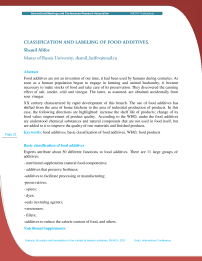Classification and labeling of food additives
Автор: Alifov Sh.
Журнал: Science, Education and Innovations in the Context of Modern Problems @imcra
Статья в выпуске: 2 vol.4, 2021 года.
Бесплатный доступ
Food additives are not an invention of our time, it had been used by humans during centuries. As soon as a human population began to engage in farming and animal husbandry, it became necessary to make stocks of food and take care of its preservation. They discovered the canning effect of salt, smoke, cold and vinegar. The latter, as assumed, are obtained accidentally from sour vinegar. XX century characterized by rapid development of this branch. The use of food additives has shifted from the area of home kitchens to the area of industrial production of products. In this case, the following directions are highlighted: increase the shelf life of products; change of its food value; improvement of product quality. According to the WHO, under the food additives are understood chemical substances and natural compounds that are not used in food itself, but are added to it to improve the quality of raw materials and finished products.
Food additives, basic classification of food additives, WHO, food products
Короткий адрес: https://sciup.org/16010084
IDR: 16010084
Текст научной статьи Classification and labeling of food additives
Experts attribute about 50 different functions to food additives. There are 11 large groups of additives:
-
- nutritional supplements (natural food components);
-
- additives that preserve freshness;
-
- additives to facilitate processing or manufacturing;
-preservatives;
-
- spices;
-
- dyes;
-
- seals (texturing agents);
-sweeteners;
-
- fillers;
-
- additives to reduce the calorie content of food, and others.
Nutritional Supplements.
Science, Education and Innovations in the context of modern problems, 05 NOV, 2021 Baku, International Conference
These supplements have a brilliant history, since with their help in developed countries it was possible to practically eliminate diseases caused by a deficiency in the diet of one or another element or substance, namely: goiter (the missing factor is iodine), scurvy (vitamin C), pellagra (niacin), rickets (vitamin D, calcium, phosphorus) and other similar diseases. Almost all microelements and macrocomponents of food (fats, carbohydrates, proteins and fiber) are added to food products to increase their nutritional value. To increase the nutritional value of food, it is very important to add to it those substances that are present in the usual diet in quantities below optimal.
Additives that keep freshness.
They include primarily antioxidants. They are added to oils and packaging materials to prevent rancidity. Chelating agents and sequestrants are also used. They prevent interactions between metals and food components, which minimizes discoloration and loss of taste and aroma. A number of substances are used to prevent browning of the fruit on the cut surface.
Additives to facilitate processing or manufacturing.
To improve the taste of food products, substances that can change the reaction to an acidic or alkaline side are very important. In addition, this group includes chelating agents and sequestrants, as well as substances that change the texture of products, cause coagulation of proteins (they are used in cheese making), contribute to color change, gelation in dairy products, making whipped cream or lightening coffee.
Preservatives.
They are antimicrobial agents designed to keep food usable for a long time. Since ancient times, 22 people have used salt, sugar, acids and smoke for this purpose, in which products were smoked. Sodium benzoate and potassium benzoate are used as preservatives for fruits and vegetables. In bakery and dairy products, propionates are used to inhibit the development of molds. Many foods are preserved with acetic acid (vinegar). Nitrites and nitrates also serve as preservatives. Dry fruits and vegetables are treated with sulfur dioxide (sulfur dioxide) and sulfites. A number of gases are used to sterilize grain products and spices to kill insect pests and microorganisms.
As the population grows, preservatives become more important, as it is much easier to provide a 10% increase in food stocks with their help than by expanding agricultural production.
Spices.
Dyes.
Science, Education and Innovations in the context of modern problems, 05 NOV, 2021 Baku, International Conference

At a time when there were no permanent trade routes providing for the import of spices, the food of the Europeans was extremely monotonous and unsatisfactory, not only in quantity, but also in quality. Nowadays, over 2000 different spices are in use for every imaginable use. Natural spices have a very complex composition; coffee, for example, contains over 1000 different compounds (however, usually spices are far from so complex). Most of the spices we use now are mixtures of synthetic substances.
The purpose of food coloring is to make processed foods look more attractive. Dyes are divided into two main groups: natural and synthetic. Now all over the world there is a craving for everything "natural" in food, and therefore, as food colorants, they increasingly tend to use purified pigments of many plants, animals (in particular insects) and microorganisms.

International Meetings and Conferences Research Association
IMCRA Publications
Texturants.
Sweeteners.
This is the name given to various additives designed to improve the texture of foods. Calcium compounds make canned tomatoes denser and stronger. Phosphates improve the taste of canned pears, making them more tender. Pyrophosphates improve the texture of instant puddings and dairy products. Emulsifiers provide stability to water and oil emulsions in salad dressings. Starch-type substances, which impart greater density to products, are found in various applications. The leavening agents provide the appropriate texture for baked baked goods and pastries.
Natural sweeteners such as sugar have been known to humans for thousands of years. They have always been mined in large quantities. However, concerns about lowering caloric intake have forced a turn to non-food sweeteners. Aspartame and acesulfame are approximately 200 times sweeter than sucrose, and work is underway to develop new, more effective artificial sweeteners.
Fillers.
This trend towards the use of non-food sweeteners has led to the search for substances that could fulfill the role traditionally played by sugars in drinks, jams, jellies and smoked meats. People have been using pregelatinized starch for centuries, but now a number of starch and cellulose derivatives have been obtained. Used polydextrose - also one of the derivatives of sugar.
Others.
A number of substances fall into this category. For example, aluminosilicate is added to food salt, so that it does not collapse into lumps, and sorbitol is added to coconut flakes so that it Page 23 remains soft, etc.
Hygienic requirements for food additives
For the production of food products, food additives and auxiliaries are allowed that do not (taking into account the established regulations), according to modern scientific research, have a harmful effect on the life and health of humans and future generations. The use of food additives and auxiliaries should not impair the organoleptic properties of products, as well as reduce their nutritional value (with the exception of some products for special and dietary purposes).
Science, Education and Innovations in the context of modern problems, 05 NOV, 2021 Baku, International Conference
It is not allowed to use food additives to hide spoilage and poor quality of raw materials or finished food products.

It is allowed to use food additives in the form of ready-made compositions - multicomponent mixtures (complex food additives). New types of food additives and aids that are not regulated by these sanitary rules are allowed in the prescribed manner.
Food products that receive food additives with raw materials or semi-finished products (secondary intake) must meet the requirements established for the finished product (the total amount of the food additive from all sources of intake is taken into account).
For food additives that do not pose a danger to human health and an excessive amount of which can lead to technical deterioration of the product, the maximum level of their introduction into food products should be determined by technological instructions (hereinafter - TI).
This TI rule does not apply to the following products: unprocessed foodstuffs, honey, wines, non-emulsified oils and fats of animal and vegetable origin, cow butter, pasteurized and sterilized milk and cream, natural mineral waters, coffee (other than instant flavored coffee) and coffee extracts, unflavored leaf tea, sugars, pasta, natural, unflavored buttermilk (except sterilized).
Food additives - acids, bases and salts are allowed for use to change the acidity of a food product, acid and alkaline hydrolysis of food raw materials, as well as to impart a sour taste to the product.
Preservatives are used to prevent bacteria and fungi from spoiling food and to increase their shelf life.
It is not allowed to use preservatives in the production of food products of mass consumption: milk, butter, flour, bread (except prepackaged and packaged for long-term storage), fresh meat, as well as in the production of dietary and baby food and food products designated as "natural" or "fresh".
When using nitrites in industrial food production, special precautions must be taken:
-
- nitrites should be delivered to the production shops only in the form of working solutions with an indication of the concentration and be there only in a specially designed closed container with the name "NITRITE";
-
- the use of containers intended for nitrite solutions for other purposes is not allowed.
Antioxidants are used to prevent oxidation of fats and other food components. Natural magnesium silicates must be free of asbestos.
To create and preserve a certain consistency in the finished food product, food additives are used - consistency stabilizers, emulsifiers, thickeners, texturers, binding agents.
Food additives - thickeners and stabilizers (modified starches, pectin, alginates, agar, carrageenan and other gums) must comply with the hygienic requirements of sanitary rules for food safety and nutritional value.
To increase the baking properties of flour, food additives are used - flour and bread improvers.
Natural, synthetic and mineral (inorganic) dyes are used to add, enhance or restore the color of food products, including for coloring the shell of Easter egg s[1]. ..
Coloring of food products is allowed as separate (individual) dyes, and combined (mixed), consisting of two or more dyes.
Food coloring additives do not include food products with a secondary coloring effect (fruit and vegetable juices or purees, coffee, cocoa, saffron, paprika and other food products).
Food colors do not include those used for coloring the inedible outer parts of food products (casings for cheeses and sausages, for branding meat, marking eggs and cheeses).
For certain types of food, only certain colorants must be used .[2]. ..
Science, Education and Innovations in the context of modern problems, 05 NOV, 2021 Baku, International Conference

For coloring the surface of some products, in addition to soluble forms of dyes, approved in accordance with the established procedure, water insoluble varnishes can be used, the maximum levels of which, when applied, must correspond to the maximum level for soluble forms of dyes.
International Meetings and Conferences Research Association
IMCRA Publications
To correct the taste and aroma of a food product, food additives are used - enhancers and modifiers of taste and arom a[4]. ..
Sweeteners are used to give food products and ready meals a sweet taste - substances of a nonsugar natur e.[5]. ..
To increase the stability of the natural color of foodstuffs, stabilizers and color (color) fixatives are use d[3]. .. To make food products shine and glossy, it is allowed to apply food additives -glazing agents on their surface.
Sweeteners are used in foods with a reduced energy value (at least 30% compared to the traditional recipe) and in special dietary products intended for people who are advised to limit their sugar intake for medical reasons. Regulatory and technical documentation and recipes for such products are agreed in accordance with the established procedure.
The use of sweeteners in the production of baby food is not allowed, with the exception of specialized products for children with diabetes. The production of sweeteners in the form of complex food additives-mixtures of individual sweeteners or with other food ingredients (fillers, solvents or food additives for other functional purposes, sugar, glucose, lactose) is allowed. The mass fraction of individual sweeteners is indicated in the regulatory and technical documentation.
It is allowed to manufacture for retail sale of sweeteners intended for use at home and catering organizations, indicating the composition of the sweeteners on the labels, their mass fraction and recommendations for their use.
When selling sweeteners containing polyhydric alcohols (sorbitol, xylitol, etc.), a warning Page 25 inscription should be applied on the label: "Consumption of more than 15-20 g per day may cause a laxative effect", and containing aspartame - "Contains a source of phenylalanine".
In food production technology, the use of filler carriers and filler solvents is allowe d[6]. ..
To impart a specific aroma and taste in the production of food products, the use of food flavorings (flavoring substances) is allowed. Food flavoring agents (hereinafter referred to as flavoring agents) do not include aqueous alcoholic infusions and carbon dioxide extracts of plant materials, as well as fruit-berry juices (including concentrated ones), syrups, wines, cognacs, spices and other products.
It is not allowed to add flavorings to natural products to enhance their natural aroma (milk, bread, directly squeezed fruit juices, cocoa, coffee and tea, except soluble ones, spices, etc.).
It is not allowed to use flavors to eliminate the change in the aroma of food products due to spoilage or poor quality of raw materials .[7]. ..
In terms of safety indicators, flavorings must meet the following requirements:
- the content of toxic elements should not exceed the permissible levels (mg / kg): lead - 5.0, arsenic - 3.0, cadmium - 1.0, mercury - 1.0;
Science, Education and Innovations in the context of modern problems, 05 NOV, 2021 Baku, International Conference

The scope and maximum dosages of flavors are set by the manufacturer, regulated in regulatory and technical documents and confirmed by a sanitary and epidemiological conclusion. The use of flavorings in the production of food products is regulated by the established technological instructions and recipes for the manufacture of these products. The content of flavoring agents in food products should not exceed the established regulations.
-
- in smoking flavors, the content of benzo (a) pyrene should not exceed 2 μg / kg (l), the contribution of smoking flavors to the content of benzo (a) pyrene in food products should not exceed 0.03 μg / kg (l);
The ingredient composition of flavors, including aromatic components, is coordinated with the Ministry of Health of Russia.
When using in the production of flavors raw materials of plant origin containing biologically active substances, the manufacturer is obliged to declare their content in the finished flavors. The content of biologically active substances in food products should not exceed the standard s[8]. ..
It is allowed to enter into the composition of flavorings food products (juices, salt, sugar, spices, etc.), fillers (solvents or carriers), food additives and substances (bitterness, tonic additives and enrichment additives) that have sanitary and epidemiological conclusions.
In ready-to-eat baby food products, the content of food additives should not exceed the standardized (maximum) levels.
Nutritional supplements are used in the production of breast milk substitute s[9]. ..
When processing raw materials and food products in order to improve the technology, the use of auxiliary means is allowe d[10]. ..
Assistive products are regulated by their main functional classes:
-
- clarifying and filtering materials, flocculants and sorbents;
-
- extraction and technological solvents;
26 - catalysts;
-
- nutrients (feeding) for yeast;
-
- enzyme preparations;
-
- materials and carriers for enzyme immobilization;
-
- other aids (with other functions not mentioned above).
In sugar production, winemaking and other sectors of the food industry, clarifying, filtering materials, flocculants and sorbents are use d[11]. ..
Catalysts are used in the production of edible oils and other product s[12]. ..
In the technology of processing raw materials and food products, it is allowed to use auxiliary means with other technological functions in accordance with the regulation s[13]. ..
In the technology of food production in the food industry, it is allowed to use enzyme preparations. Enzyme activity in finished food products should not be detectable.
Science, Education and Innovations in the context of modern problems, 05 NOV, 2021 Baku, International Conference

In the production of fatty products and some food additives (flavorings, dyes, etc.), extraction and technological solvents are used. In the production of bread and bakery products, nutritional yeast, nutrients (feeding, substrate) for yeast are used.
To obtain enzyme preparations as sources and producers, it is allowed to use organs and tissues of healthy farm animals, cultivated plants, as well as non-pathogenic and non-toxic special strains of microorganisms of bacteria and lower fungi in accordance with the regulation s[14]. ..
International Meetings and Conferences Research Association
IMCRA Publications
In the regulatory and technical documentation for enzyme preparations, it is necessary to indicate the source of the preparation and its characteristics, including the main and additional activity.
For strains of microorganisms - producers of enzymes, the following information should additionally be provided:
To standardize the activity and increase the stability of enzyme preparations, it is allowed to enter food additives (potassium chloride, sodium phosphate, glycerin and others) in their composition, permitted in the prescribed manner. For the production of enzyme preparations, auxiliary means may be used as immobilizing materials and solid carriers .[15]. ..
-
- information about the taxonomic position (generic and specific name of the strain, number and original name; information about deposition in the collection of cultures and about modifications);
-
- materials on studies of cultures for toxigenicity and pathogenicity (for strains of representatives of genera, among which there are conditionally pathogenic microorganisms);
-
- declaration on the use of strains of genetically modified microorganisms in the production of enzyme preparations.
In terms of safety indicators, enzyme preparations must meet the following requirements:
-
- the content of toxic elements should not exceed: lead - 10.0 mg / kg, arsenic - 3.0 mg / kg;
-
- in terms of microbiological parameters, enzyme preparations must meet the following requirements:
-
- the number of mesophilic aerobic and facultative anaerobic microorganisms (KMAFAnM), Page 27 CFU / g, no more - 5 10 (for enzyme preparations of plant, bacterial and fungal origin), 1 10 (for enzyme preparations of animal origin, including milk-curdling) ;
-
- bacteria of the group of Escherichia coli (BGKP, coliforms) in 0.1 g - not allowed;
-
- pathogenic microorganisms, including salmonella, in 25 g - are not allowed;
-
- E. coli in 25 g - not allowed;
-
- enzyme preparations should not contain viable forms of enzyme producers;
Science, Education and Innovations in the context of modern problems, 05 NOV, 2021 Baku, International Conference
- enzyme preparations of bacterial and fungal origin should not have antibiotic activity;
- enzyme preparations of fungal origin should not contain mycotoxins (aflatoxin B, T-2 toxin, zearalenone, ochratoxin A, sterigmatocystin).

2. Available from:
When controlling the content of mycotoxins in enzyme preparations, it should be borne in mind that the producers of mycotoxins are most often toxigenic strains of fungi: Aspergillus flavus and Aspergillus parasiticus - for aflatoxins and sterigmatocystin; Aspergillus ochraceus and Penicillium verrucosum, less often - Aspergillus sclerotiorium, Aspergillus melleus, Aspergillus alliaceus, Aspergillus sulphureus - for ochratoxin A; Fusarium graminearum, less often other Fusarium species - for zearalenone, deoxynivalenol and T-2 toxin.

International Meetings and Conferences Research Association
IMCRA Publications


